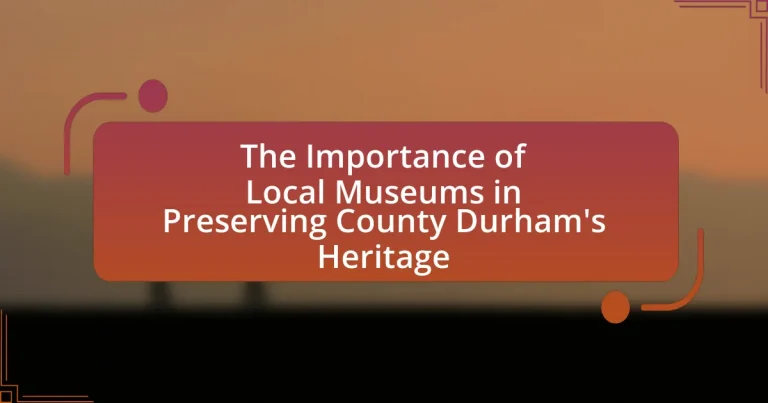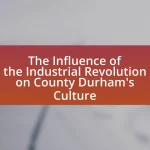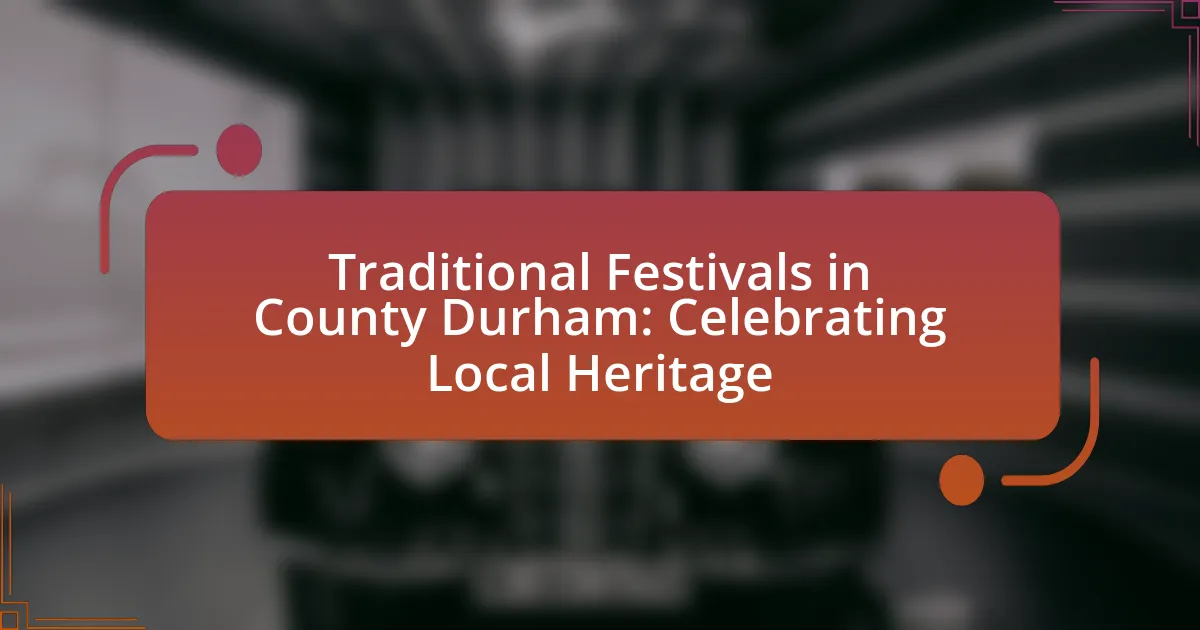Local museums are essential in preserving County Durham’s heritage by collecting, conserving, and interpreting artifacts that reflect the region’s rich history, including its mining and industrial past. They serve as custodians of local culture, offering educational programs and community engagement initiatives that foster awareness and appreciation of the area’s unique heritage. The article explores the specific heritage elements highlighted by these museums, the challenges they face, the role of technology in enhancing visitor experiences, and the importance of community support in sustaining their mission. Additionally, it discusses strategies for increasing museum visitation and promoting local heritage initiatives.
What is the role of local museums in preserving County Durham’s heritage?
Local museums play a crucial role in preserving County Durham’s heritage by collecting, conserving, and interpreting artifacts and historical narratives specific to the region. These institutions safeguard items of cultural significance, such as archaeological finds, local art, and historical documents, which reflect the area’s rich history, including its mining heritage and industrial past. For instance, the Bowes Museum houses an extensive collection of decorative arts and historical artifacts that illustrate the region’s cultural evolution. Additionally, local museums engage the community through educational programs and exhibitions, fostering a sense of identity and continuity among residents. By documenting and showcasing County Durham’s unique stories, local museums ensure that future generations can access and appreciate their heritage.
How do local museums contribute to cultural preservation?
Local museums contribute to cultural preservation by collecting, conserving, and exhibiting artifacts that represent the history and heritage of their communities. These institutions serve as custodians of local culture, ensuring that significant objects, documents, and stories are maintained for future generations. For instance, County Durham’s local museums often showcase items related to the region’s mining history, agricultural practices, and traditional crafts, which are vital for understanding the area’s cultural identity. By providing educational programs and community engagement initiatives, these museums foster awareness and appreciation of local heritage, thereby reinforcing its significance within the community.
What specific heritage elements do local museums focus on?
Local museums focus on specific heritage elements such as artifacts, historical documents, and cultural traditions unique to their region. In County Durham, for instance, museums often highlight the area’s mining history, showcasing tools and equipment used in coal mining, as well as personal stories from miners. Additionally, they preserve local art, crafts, and exhibitions that reflect the community’s cultural identity, such as the history of the Durham Cathedral and its architectural significance. These elements are crucial for educating visitors about the region’s past and fostering a sense of local pride.
How do local museums engage with the community to promote heritage?
Local museums engage with the community to promote heritage through educational programs, exhibitions, and collaborative events. These initiatives often include workshops, lectures, and guided tours that highlight local history and cultural practices, fostering a sense of identity and belonging among residents. For instance, museums may partner with schools to create curriculum-based activities that encourage students to explore their local heritage, thereby increasing community involvement and awareness. Additionally, local museums frequently host community events, such as heritage festivals, which celebrate regional traditions and attract diverse audiences, reinforcing the importance of preserving County Durham’s unique cultural legacy.
Why are local museums vital for education and awareness?
Local museums are vital for education and awareness because they provide accessible platforms for community engagement and learning about regional history and culture. These institutions curate artifacts and exhibits that reflect the unique heritage of areas like County Durham, allowing visitors to connect with their local identity. Research indicates that museums enhance educational outcomes; for instance, a study by the American Alliance of Museums found that 85% of teachers believe museum visits improve student learning. By fostering a deeper understanding of local history, museums play a crucial role in preserving cultural narratives and promoting civic pride.
What educational programs do local museums offer?
Local museums offer a variety of educational programs, including guided tours, workshops, and interactive exhibits designed to engage visitors of all ages. These programs often focus on local history, art, and culture, providing hands-on learning experiences that enhance understanding of County Durham’s heritage. For example, many museums collaborate with schools to create tailored educational resources that align with curriculum standards, ensuring that students gain valuable insights into their local history. Additionally, museums frequently host special events, lectures, and community outreach initiatives that further promote educational engagement and awareness of the region’s cultural significance.
How do local museums raise awareness about County Durham’s history?
Local museums raise awareness about County Durham’s history through educational programs, exhibitions, and community engagement initiatives. These institutions curate artifacts and displays that highlight significant historical events and figures from the region, such as the coal mining heritage and the role of the Durham Cathedral. Additionally, museums often collaborate with schools and local organizations to host workshops and guided tours, fostering a deeper understanding of the area’s cultural significance. For instance, the Durham Museum and Heritage Centre regularly organizes events that attract both residents and tourists, effectively promoting local history and heritage.

What challenges do local museums face in preserving heritage?
Local museums face significant challenges in preserving heritage, primarily due to limited funding and resources. Many local museums operate on tight budgets, which restricts their ability to maintain and conserve artifacts, leading to deterioration over time. For instance, a report by the Museums Association in 2020 highlighted that 60% of museums in the UK reported cuts to their funding, impacting their preservation efforts. Additionally, local museums often struggle with a lack of trained staff, which hampers their ability to implement effective conservation techniques. This combination of financial constraints and staffing issues poses a serious threat to the preservation of cultural heritage within local communities.
How do funding and resources impact local museums?
Funding and resources significantly impact local museums by determining their operational capacity, exhibit quality, and community engagement. Adequate funding allows museums to maintain and enhance their collections, develop educational programs, and host events that attract visitors. For instance, a study by the American Alliance of Museums found that museums with stable funding sources are more likely to offer diverse programming and maintain higher visitor satisfaction rates. Additionally, resources such as skilled staff and modern technology enable museums to create interactive exhibits that foster learning and appreciation of local heritage, which is crucial for preserving the cultural identity of regions like County Durham.
What are the common funding sources for local museums?
Common funding sources for local museums include government grants, private donations, membership fees, and fundraising events. Government grants often come from local, state, or federal agencies aimed at supporting cultural institutions, while private donations can be sourced from individuals or businesses interested in community development. Membership fees provide a steady income stream, as many museums offer annual memberships that grant benefits to supporters. Fundraising events, such as auctions or community fairs, also generate revenue and engage the public. According to the American Alliance of Museums, approximately 30% of museum funding comes from government sources, highlighting the significance of these financial avenues in sustaining local museums.
How can resource limitations affect museum operations?
Resource limitations can significantly hinder museum operations by restricting funding, staffing, and resources necessary for effective management and programming. For instance, a lack of financial resources can lead to reduced exhibition quality, limited educational programs, and inadequate maintenance of collections, which are essential for preserving heritage. According to a report by the American Alliance of Museums, 30% of museums in the U.S. reported budget cuts that directly impacted their ability to provide public services and maintain collections. This demonstrates that insufficient resources can compromise a museum’s mission to educate and engage the community, ultimately affecting its role in preserving local heritage, such as that of County Durham.
What role does technology play in modernizing local museums?
Technology plays a crucial role in modernizing local museums by enhancing visitor engagement and improving operational efficiency. For instance, the integration of virtual reality (VR) and augmented reality (AR) allows museums to create immersive experiences that bring historical artifacts and narratives to life, making them more accessible and engaging for diverse audiences. Additionally, digital collections and online databases enable broader access to museum resources, allowing individuals to explore exhibits remotely, which can increase overall visitor numbers and interest. According to a 2021 report by the American Alliance of Museums, 70% of museums that adopted digital tools reported increased visitor engagement, demonstrating the effectiveness of technology in revitalizing local museums.
How are local museums using technology to enhance visitor experiences?
Local museums are using technology to enhance visitor experiences through interactive exhibits, virtual reality tours, and mobile applications. Interactive exhibits allow visitors to engage with artifacts in a hands-on manner, increasing educational value and enjoyment. Virtual reality tours provide immersive experiences that transport visitors to historical events or locations, making history more relatable and engaging. Mobile applications offer features such as audio guides, augmented reality overlays, and event notifications, facilitating personalized and informative visits. These technological advancements have been shown to increase visitor satisfaction and engagement, as evidenced by a study from the American Alliance of Museums, which reported that 70% of visitors appreciated interactive elements in exhibitions.
What digital initiatives are being implemented for heritage preservation?
Digital initiatives for heritage preservation include the use of 3D scanning and modeling, virtual reality experiences, and online databases for archival materials. These technologies enable museums to create accurate digital representations of artifacts and sites, making them accessible to a wider audience. For instance, the use of 3D models allows users to explore heritage sites remotely, while online databases facilitate research and education by providing access to historical documents and images. Such initiatives have been shown to enhance public engagement and awareness of local heritage, as evidenced by projects like the “Digital Durham” initiative, which aims to digitize and share the region’s historical resources.

How can the community support local museums in their mission?
The community can support local museums in their mission by actively participating in fundraising efforts and volunteering. Engaging in fundraising initiatives helps museums secure necessary financial resources for exhibitions and educational programs, which are vital for preserving heritage. For instance, community-driven events like bake sales or art auctions can raise significant funds, as evidenced by the success of similar initiatives in other regions, where local support increased museum revenue by up to 30%. Additionally, volunteering provides essential manpower for daily operations and special events, allowing museums to enhance visitor experiences and expand outreach programs. Research shows that museums with strong community volunteer programs report higher visitor satisfaction and increased community engagement, reinforcing the importance of local involvement in sustaining these cultural institutions.
What volunteer opportunities exist within local museums?
Local museums offer various volunteer opportunities, including roles in education, curation, visitor services, and event planning. Volunteers can assist with guided tours, educational programs, and workshops, enhancing visitor engagement and learning experiences. Additionally, they may help with the organization and maintenance of exhibits, contributing to the preservation of artifacts and historical materials. Many museums also seek volunteers for administrative tasks and community outreach initiatives, which are essential for fostering connections with the public and promoting local heritage. These roles not only support museum operations but also provide volunteers with valuable skills and experiences in cultural preservation.
How can community members contribute to museum programs?
Community members can contribute to museum programs by volunteering their time, sharing local knowledge, and participating in events. Volunteers assist with various tasks such as guiding tours, organizing exhibitions, and conducting educational workshops, which enhances the museum’s offerings. Additionally, local residents can share their personal stories and artifacts, enriching the museum’s collection and providing a deeper understanding of County Durham’s heritage. Participation in community events fosters a sense of ownership and connection to the museum, ultimately supporting its mission to preserve local history.
What are some best practices for engaging with local museums?
To effectively engage with local museums, individuals should participate in community events, volunteer, and provide feedback on exhibits. Engaging in community events, such as workshops or lectures, fosters a deeper understanding of the museum’s role in preserving heritage. Volunteering allows individuals to contribute directly to museum operations, enhancing their connection to the institution. Providing feedback on exhibits helps museums tailor their offerings to better serve the community’s interests and educational needs. These practices not only strengthen community ties but also support the museum’s mission of preserving and promoting local heritage.
How can individuals promote local museum events and initiatives?
Individuals can promote local museum events and initiatives by leveraging social media platforms, community bulletin boards, and local partnerships. Utilizing social media allows individuals to share event details, engage with a broader audience, and create buzz around museum activities. Community bulletin boards in local cafes, libraries, and schools serve as effective physical spaces for disseminating information. Collaborating with local businesses and organizations can enhance visibility through cross-promotion, as evidenced by studies showing that community partnerships increase event attendance by up to 30%. These strategies collectively foster greater community engagement and awareness of local museums’ contributions to preserving County Durham’s heritage.
What strategies can be employed to increase museum visitation?
To increase museum visitation, local museums can implement targeted marketing campaigns, community engagement initiatives, and enhanced visitor experiences. Targeted marketing campaigns can utilize social media and local advertising to reach specific demographics, as studies show that effective marketing can increase awareness and interest in museum offerings. Community engagement initiatives, such as partnerships with schools and local organizations, can foster a sense of ownership and relevance, leading to increased foot traffic; for instance, programs that offer free admission days or educational workshops have been shown to attract larger audiences. Enhancing visitor experiences through interactive exhibits and guided tours can also significantly boost attendance, as research indicates that immersive experiences lead to higher visitor satisfaction and repeat visits.




